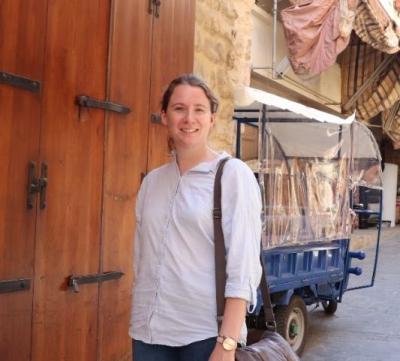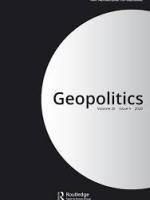Jordan: How the EU is using trade deals to curb migration
The impact of EU migration policy now stretches far beyond the Union’s actual territorial borders, with billions of euros invested in efforts to control and curb mobility from and between African and Middle Eastern countries – also known as border ‘externalisation’. Such initiatives are profoundly impacting the lives of migrants themselves as well as entire political and policy-making landscapes within the countries from which they move.

In this interview Zoe Jordan, a researcher on the interdisciplinary project Effects of Externalisation: EU Migration Management in Africa and the Middle East (EFFEXT), explains how the EU is externalising its borders into Jordan.
Over the last 10 years, Jordan has hosted one of the largest per capita refugee populations in the world. The World Bank estimated that there were over 3 million refugees living in Jordan in 2020 – compared to over 2.6 million in the whole of the European Union in the same year. Around two thirds of Jordan’s refugees are Palestinians, while the Jordanian government estimates there to be 1.3 million Syrian refugees living there.
The EFFEXT project explores how the EU’s external borders are managed and maintained, and the impact this has on policy-making in six case countries: Jordan, Lebanon, Libya, Senegal, Ghana and Ethiopia.
Your work focuses on the effects of EU external migration policy in Jordan. What is the EU doing there?
In 2016, the government of Jordan signed an agreement with the EU called the Jordan Compact. This agreement opened up financial and technical assistance as well as better access to EU markets to Jordan, in exchange for more work options for Syrians in Jordan. The aim was to increase Syrians’ self-reliance in Jordan and thereby remove one ‘push factor’ which may spur onwards movement [towards Europe].
It’s one of the big policy events of recent years and has shaped how governments and the international community are responding to refugee movements, not only in Jordan but around the world – for example, similar compacts have been talked about in Lebanon and Ethiopia, and refugees’ self-reliance is a main objective of the new Global Compact on Refugees.
Access to formal work is potentially life-changing for refugees, but there have been a lot of concerns about the process of how and why the Compact took the form it did and how it’s been implemented. Many refugees have been excluded or found it hard to access permits. Different actors are now thinking about its future, but we need to make sure such agreements work for refugees.
The EU Regional Trust Fund in Response to the Syrian Crisis (Madad) is also ending. Madad has provided funding for education, livelihoods, and healthcare, supporting the Jordanian government to host refugees. It is not yet fully clear what is going to come next, so there is a lot of uncertainty!
We rarely hear about Jordan in public debates on migration in Europe. Why do you think this is?
Jordan and other Middle Eastern countries are not seen as an immediate geographical border of Europe in quite the same way as parts of West Africa, for instance. This means EU policy in Jordan focuses on how to keep primarily refugees, but also other migrants, contained within the region – rather than directly stopping movement to Europe. Jordan isn’t a direct embarkation point to the same extent.
I think this points to something else: in policy and public imagination, migration from the Middle East is mainly talked about in relation to Syrians, and therefore refugees. This is perhaps different from the assumptions made about people moving from Africa, who are often depicted as economic migrants. That said, I think it’s very important to challenge these assumptions, and to look at who is actually migrating and why.
You mentioned the significance of the Jordan Compact in relation to the international response to refugees. Of course, the EU has a clear motive here in curbing large movements of Syrian refugees to European states. But what is Jordan’s motivation?
I think they were hoping that a better trade deal with the EU would result in more investment in Jordanian businesses. The deal also came with international financial support, in the form of aid and concessional loans. Other researchers have noted that Jordan is largely reliant on external financing, and hosting a large and visible refugee population has galvanized financial support from the EU.
The Jordanian government ensures that international aid supports vulnerable Jordanians as well as refugees, so the agreement also helped meet the needs of Jordanians, thereby perhaps pre-empting more serious social tensions within the country. However, it could be seen as a risky move – unemployment in Jordan is high, so opening up employment to refugees was politically challenging, and I don’t think Jordan has necessarily seen the investment returns it was hoping for.
Could you speak about how this relates to EU external migration policy in Middle Eastern and North African (MENA) countries more generally – can we see some regional patterns here compared to, say, what the EU is doing in West Africa?
The first thing that springs to mind is that EU externalization policy in MENA countries has largely been about containing Syrian refugees in the region. However, one of the things I’m really looking forward to in the EFFEXT project is the chance to think more deeply about the differences between countries in the MENA region, and between the MENA region and West Africa.
I think Lebanon and Jordan are very often considered together, but they have such different histories, interests, and contexts. Particularly at the moment, Lebanon is experiencing a deep and compounded political, economic, and financial crisis, and there is perhaps a much stronger rhetoric pushing Syrians in Lebanon to return to Syria. Those dynamics aren’t present to the same extent in Jordan at the moment.
I’m also really interested in how policy in some of the countries we are studying may have unintended knock-on effects in other countries considered in the project. For example, there is a relatively large proportion of migrant domestic workers in Jordan who come from Ethiopia through the kafala system, which ties someone’s presence in the country to their employer.
Is there an interaction between national and EU policy that is being implemented in Jordan and Ethiopia that creates this route? And domestic workers are often women, so is there a gendered impact of external migration policies?
These are critical questions that touch on issues which remain relatively understudied. Why do you think this is?
There has been plenty of research on EU external migration policy – but it’s largely been from the perspective of EU actors, and in relation to their interests and priorities. I imagine this is partly because a lot of the money funding research is coming from within the EU. Perhaps there is also an assumption that the EU is a big financial and political player that is capable of imposing its agenda elsewhere.
Without downplaying the power differences between the EU and the countries we’re working in, I think that would be far too simplistic an understanding of the dynamics at play. That’s where the EFFEXT project is doing something different: we’re really trying to understand how these policy processes are being perceived and engaged in from the perspective of non-EU actors.
These perspectives have been rather less considered in the scholarship around migration policy, but they are absolutely crucial in understanding which policies gain traction, which are actually taken on in legislation and regulations, and how they are put into practice.
I hope the project will help us understand both how partners can work together to create and implement more coherent policy, but also whether such policies are actually aiming at the ‘right’ thing – which interests are they advancing, and who are they working for?



